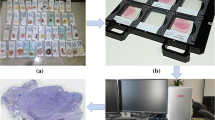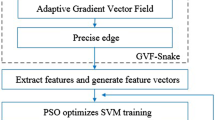Abstract
Abnormal cell detection by optical microscopy is widely used, and a large number of biopsies required where the process of determining cell’s position in the histological sample image are very time consuming. In this paper, a proof-of-concept study was done to segmented abnormal cells in real time with high performance metrics focusing on minimizing cost and maximizing efficiency. We developed an improved snake/active contour method for fast cancer cells detection by integrated Canny approach. The implementation of this algorithm on Field-Programmable Gate Array (FPGA) technology substantially decreases the required time for identifying abnormal cells. It also allows an efficient and fast computation of active contour in high throughput image analysis applications where time performance is critical. In order to demonstrate the feasibility of this approach, we implemented the architecture on Xilinx Virtex-FPGAs technology which offers for a scalable and a totally embedded on Chip FPGA. The proposed architecture was validated using 30 images from each histopathological type of colon cells, namely, Benign Hyperplasia (BH), Intraepithelial Neoplasia (IN) and Carcinoma (Ca). This method successfully detected the different cell types with computation time in the order of milliseconds. It was compared with manual cells segmented by using the performance metrics of similarity. The experimental results showed that the proposed snake implementation on FPGA produced accurate and stable results. It was able to rapidly identify multiple cellular types from optical microscope images, and effectively addressed difficult problems such as irregular shapes in carcinoma cells. The short computation time in this method makes it applicable to real-time cancer cell detection.












Similar content being viewed by others
References
Chen CH. Computer vision in medical imaging. WORLD SCIENTIFIC. 2014;2.
Srivastava R, Singh SK, Shukla KK (Éd). Research developments in computer vision and image processing: methodologies and applications. IGI Global. 2014.
Castañón CAB, Fraga JS, Fernandez S, Gruber A, da F Costa L. Biological shape characterization for automatic image recognition and diagnosis of protozoan parasites of the genus Eimeria. Pattern Recognit. 2007;40(7):1899–910.
Wang X, Li S, Liu H, Wood M, Chen WR, Zheng B. Automated identification of analyzable metaphase chromosomes depicted on microscopic digital images. J Biomed Inform. 2008;41(2):264–71.
Sabino DMU, da Fontoura Costa L, Gil Rizzatti E, Antonio Zago M. A texture approach to leukocyte recognition. Real-Time Imaging. 2004;10(4):205–16.
Chaddad A, Tanougast C, Dandache A, Houseini A Al, Bouridane A. Improving of colon cancer cells detection based on Haralick’s features on segmented histopathological images. Computer Applications and Industrial Electronics (ICCAIE). 2011. p. 87–90.
Chaddad A, Tanougast C, Dandache A, Bouridane A. Classification of cancer cells based on morphological features from segmented multispectral bio-images. 4th International Conference on Biomedical Electronics and Biomedical Informatics. 2011. p. 92–97.
Wienert S, Heim D, Saeger K, Stenzinger A, Beil M, Hufnagl P, Dietel M, Denkert C, Klauschen F. Detection and segmentation of cell nuclei in virtual microscopy images: a minimum-model approach. Sci. Rep. 2012;2.
Chaddad A, Tanougast C, Dandache A, Bouridane A. Extracted haralick’s texture features and morphological parameters from segmented multispectrale texture bio-images for classification of colon cancer cells. WSEAS Trans Biol Biomed. 2011;8(2):39–50.
Steffen Klupsch ME. Real time image processing based on reconfigurable hardware acceleration. 2002.
Isabel PNF, Figueiredo N. Variational image segmentation for endoscopic human colonic aberrant crypt foci. IEEE Trans Med Imaging. 2009;29(4):998–1011.
Dejnožková Eva DP. Embedded real-time architecture for level-set-based active contours. EURASIP J. Adv. Signal Process. 2005.
Tsuyama H, Maruyama T. An FPGA acceleration of a level set segmentation method. 22nd International Conference on Field Programmable Logic and Applications (FPL), 2012. p. 414–20.
Sugiura T, Takeguchi T, Sakata Y, Nitta S, Okazaki T, Matsumoto N, et al. Automatic model-based contour detection of left ventricle myocardium from cardiac CT images. Int J Comput Assist Radiol Surg. 2013;8(1):145–55.
Farmaki C, Marias K, Sakkalis V, Graf N. Spatially adaptive active contours: a semi-automatic tumor segmentation framework. Int J Comput Assist Radiol Surg. 2010;5(4):369–84.
Hosntalab M, Babapour-Mofrad F, Monshizadeh N, Amoui M. Automatic left ventricle segmentation in volumetric SPECT data set by variational level set. Int J Comput Assist Radiol Surg. 2012;7(6):837–43.
Zheng Y, Barbu A, Georgescu B, Scheuering M, Comaniciu D. Four-chamber heart modeling and automatic segmentation for 3-D cardiac CT volumes using marginal space learning and steerable features. IEEE Trans Med Imaging. 2008;27(11):1668–81.
Hiraoka Y, Sedat JW, Agard DA. The use of a charge-coupled device for quantitative optical microscopy of biological structures. Science. 1987;238(4823):36–41.
Miller PJ, Hoyt CC. Multispectral imaging with a liquid crystal tunable filter. 1995;2345:354–365.
Roula M, Diamond J, Bouridane A, Miller P, Amira A. A multispectral computer vision system for automatic grading of prostatic neoplasia. In: 2002 I.E. International Symposium on Biomedical Imaging, 2002. Proceedings,2002. p. 193‑196.
Kass M, Witkin A, Terzopoulos D. Snakes: active contour models. Int J Comput Vis. 1988;1(4):321–31.
Caselles V, Catté F, Coll T, Dibos F. A geometric model for active contours in image processing. Numer Math. 1993;66(1):1–31.
Malladi R, Sethian JA, Vemuri BC. Shape modeling with front propagation: a level set approach. IEEE Trans Pattern Anal Mach Intell. 1995;17(2):158–75.
He L, Peng Z, Everding B, Wang X, Han CY, Weiss KL, et al. A comparative study of deformable contour methods on medical image segmentation. Image Vis Comput. 2008;26(2):141–63.
Chen SY, Guan Q. Parametric shape representation by a deformable NURBS model for cardiac functional measurements. IEEE Trans Biomed Eng. 2011;58(3):480–7.
Chen S, Zhao M, Wu G, Yao C, Zhang J. Recent advances in morphological cell image analysis. Comput Math Methods Med. 2012;2012.
Canny J. A computational approach to edge detection. IEEE Trans Pattern Anal Mach Intell. 1986;PAMI-8(6):679–98.
Jaccard P. The distribution of the flora in the alpine zone.1. New Phytol. 1912;11(2):37–50.
Dice LR. Measures of the amount of ecologic association between species. Ecology. 1945;26(3):297–302.
Virtex-5 FPGA Devices. [En ligne]. Disponible sur: http://www.xilinx.com/onlinestore/silicon/online_store_v5.htm. [Consulté le: 16-juin-2015].
« Tutorials : ISE 9 Software Tutorials ». [En ligne]. Disponible sur: http://www.xilinx.com/support/techsup/tutorials/tutorials9.htm. [Consulté le: 16-juin-2015].
bookfile.book - mb_tutorial_c2bits.pdf.
ARM Architecture Reference Manual - arm_arm.pdf.
Chaddad A, Maamoun M, Tanougast C, Dandache A. Hardware implementation of active contour algorithm for fast cancer cells detection. Biomedical Engineering Conference (SBEC), 2013 29th Southern, 2013, p. 129–130.
Siéler L, Tanougast C, Bouridane A. A scalable and embedded FPGA architecture for efficient computation of grey level co-occurrence matrices and Haralick textures features. Microprocess Microsyst. 2010;34(1):14–24.
Chaddad A, Tanougast C, Golato A, Dandache A. Carcinoma cell identification via optical microscopy and shape feature analysis. J Biomed Sci Eng. 2013;06(11):1029–33.
Acknowledgments
The authors would like to acknowledge the service Anapat of the CHU hospital of the Nancy-Brabois and the Architecture of Embedded Systems and Smart Sensors (ASEC) team.
Compliance with Ethical Standards
The authors declare that there is no conflict of interest regarding the publication of this article and the materials are in compliance with all applicable laws, regulations and policies for the protection of medical data, and any necessary approvals, authorizations, and informed consent documents were obtained.
Conflict of interest
The authors declare that there is no conflict of interest regarding the publication of this article.
Support
This work was supported by the ASEC-LCOMS laboratory for Scantis project.
Author information
Authors and Affiliations
Corresponding author
Rights and permissions
About this article
Cite this article
Chaddad, A., Tanougast, C. Real-time abnormal cell detection using a deformable snake model. Health Technol. 5, 179–187 (2015). https://doi.org/10.1007/s12553-015-0115-1
Received:
Accepted:
Published:
Issue Date:
DOI: https://doi.org/10.1007/s12553-015-0115-1




